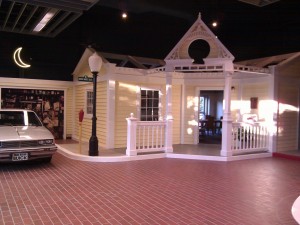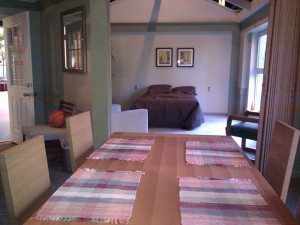Location, Location, Location! Choosing a Teaching Space for Maximum Learner Value and Retention
By: Sharon Muza, BS, LCCE, FACCE, CD/BDT(DONA), CLE | 0 Comments
Lamaze Childbirth Educators work hard to be innovative and creative when designing their childbirth classes. Today's post is another in an occasional series highlighting different methods for teaching birth classes. Kim James, CD(DONA), CD(PALS), ICCE, LCCE, BDT(DONA), who demonstrates that with some planning and thinking 'outside the box,' childbirth educators can enhance the learning experience and confidence of the families that are going through their childbirth classes. Kim shares her techniques for using her local hospital's 'Easy Street® Rehabilitation simulation environment' for her Lamaze classes in Seattle, WA.
Here is the first post in the series. Do you teach in an unusual location, an uncommon way or a unique population. Please contact me, Sharon Muza, S&S Community Manager if you are interested in being profiled and sharing your individuality!- SM
When you train for a marathon, practicing on the actual race course helps you familiarize with what to expect, uncover potential challenges and pitfalls and increase your confidence that you'll know what to do when the time comes. Route familiarity equals increased confidence about one's ability to navigate the course by removing uncertainty and results in more satisfaction with the race event.
Couldn't the same be true for teaching Lamaze classes? What if we taught our classes in the actual places where women have their babies? We know the birth environment critically influences the laboring woman's behavior, often by increasing or decreasing her fear, tension and pain. (Nolan and Foster, 2005 and Hodnett, et al, 2009) What if women felt like they owned their childbirth space, free to move, sing, and manipulate the environment to her advantage and comfort?
By choosing to teach in the very rooms where women will give birth, we as Lamaze childbirth educators can help women and their families:
1) Increase their control over their responses and reactions to their labors
2) Create realistic expectations about what is possible
3) Become confident and challenging consumers of maternity care services
4) Increase the value and relevance of our classes to the families we serve
Very few of the families who take our classes plan to have their babies in the conference rooms, lecture halls and lobbies where classes are often scheduled. Let's expand our vision of where classes need to be located for maximum relevance and skill retention.
The idea is not new. In 'Birth and Parenting Skills: New Directions in Antenatal Education' (2005), Mary Nolan and Julie Foster describe the 'Birth Ideas Workshops' at Birmingham Women's Hospital (United Kingdom) where sessions are held in a labor and delivery rooms. The genesis of birthing room childbirth preparation classes come from this idea:
'Women need to know that they aren't merely visitors to the labor and delivery floor. They have the right to negotiate and to adapt the environment where possible to fit with their needs.'

Car and Home available for practice
When I first heard about the Birth Ideas Workshops, teaching Lamaze classes in an actual labor and delivery room captured my imagination. In 2012, I finally had the opportunity to try it.
Teaching Lamaze classes outside the classroom wouldn't have been possible without the incredible team at Northwest Hospital and Medical Center in Seattle, Washington. The encouragement by Cheryl Cummings BSN,RN,CDE, Clinical Coordinator, Diabetes Services and Community Education leader to use all available resources within the hospital was particularly valuable.
The importance of team-wide support cannot be overstated. In Nolan and Foster's experience of setting up the Birth Ideas Workshops at Birmingham Women's Hospital, the biggest challenge were the attitudes of staff whose practice over the years had become entrenched in the medical model and routine ways of conducting childbirth classes and labor and delivery tours. The gracious, collaborative and can-do attitude of the clinical and support staff at Northwest Hospital and Medical Center meant my requests for trying something new were always met with 'How can we help?'
Besides the fantastic staff, Northwest Hospital and Medical Center has another element that made this the right place for teaching Lamaze classes outside the classroom: The Easy Street® Rehabilitation simulation environment. This life-size replica of a city street, including a grocery store, restaurant, bank, laundromat, bus stop, movie theater and home with a kitchen, dining room, bedroom and car allows class members to practice physical coping skills and comfort measures in a real-world setting. It's enough to make any childbirth educator drool. See all the amenities of Easy Street at the virtual tour here.
When Do I Get Out of the Classroom?
I teach an eight-week Lamaze series of two-hour-long classes. In the first five weeks, we spend 30% of our class time practicing physical and mental coping skills. In classes 1-3, we are mostly in our classroom, learning and practicing basic coping skills. By class 4 and 5, we're ready to apply our skills in real-world settings.
Here's our typical physical coping skill practice schedule:Class 1 (classroom): Body awareness, relaxation and conditioning exercises (30 mins)
Class 2 (classroom, Easy Street): Positions, movement and touch relaxation techniques (30 mins). We visit Easy Street to talk about how to manage early labor at home. The simulation area provides real life opportunities to practice and imagine using coping skills while in a restaurant, movie theatre and grocery store. Parents can visualize going about their day and how they'd plan their reactions if they had a few contractions in public places.
Class 3 (classroom): Positioning, strategies and techniques for pushing in the second stage (30 minutes)
Class 4 (Easy Street): Coping skills and positioning techniques for long, slow labors and labors complicated by back pain. (45 mins). By holding class in the Easy Street simulation, we have access to:
- Curbs to practice curb walking for asymmetric pelvic positioning
- Kitchen counters where partners and pregnant parents can practice dangle squatting.
- A dining room table for forward-leaning positions.
- Stairs to practice lunges.
- A plush, full size bed for getting into open-knee chest and exaggerated sims positions.
- A full size car for strategizing how to cope with contractions on the ride to the birth place while in labor.
- Chairs, both straight-back and upholstered for practicing knee presses.
- A freezer and microwave for hot and cold back pain comfort measures.
- Comfortable, clean carpeting and rugs for getting on the floor to practice the double hip squeeze
Class 5 (labor and delivery room): All coping skills, positioning and relaxation techniques learned in the previous four classes. (45 minutes) On our final night we apply everything we've learned in an actual labor and delivery room using a labor rehearsal game. Class members a play Cranium-style game where they act out a variety of labor scenarios. During the labor rehearsal, class members get to:
- Configure the bed for a variety of pushing positions
- Set up the squat bar
- Locate and use the birth balls
- Strategize on a variety of positions and coping techniques for the bath and shower.
- Practice lunging, squatting and dangling using the counters, chairs tray tables, stools and benches in the labor and delivery room.
- Retrieve ice and water from the nutrition area
- Locate where towels and wash cloths are kept.
- Figure out how to manipulate the room's ambience (lights, temperature, fresh air) to suit their needs.
By the end of class five, class members by and large feel they 'own' their labor and delivery space. Comments from class members in July, 2012:
'I'm feeling a lot more confident about being here. My anxiety and fear are so much lower. ' 'I know what to ask for'. 'I could really see myself just staying in the bathroom with the door closed for most of the time'. 'Could I just have my baby in that little house? Will the nurses come down there?'

Bedroom, dining room and kitchen (not visible)
available for practice
To conclude, I urge my fellow Lamaze educators to think about the location where you teach. Does your location add value and relevance to your content? Are you able to easily practice physical and mental coping skills? What would it take to teach all or part of your Lamaze classes outside the classroom for increased value and relevance to your class members?
References
Hodnett, E. D., Stemler, R., Weton, J. A. McKeever, P., Re-Conceptualizing the Hospital Labor Room: The PLACE (Pregnant and Laboring in an Ambient Clinical Environment) Pilot Trial, May 2009.
Nolan, M. L., and Foster, J., Birth and Parenting Skills: New Directions in Antenatal Education (Elsevier, 2005) 85.
About Kim James
 Kim James is an ICEA and Lamaze International certified childbirth educator teaching at Parent Trust for Washington Children/Great Starts where she sits on the Education Committee. She owns and operates www.DoulaMatch.net and is a DONA International and PALS Doulas certified birth doula as well as a DONA-approved birth doula trainer working at the Simkin Center/Bastyr University. Kim also volunteers her time on the Lamaze International membership committee and serves as Washington State DONA SPAR. Her daughters are 7 and 14 years old. Kim and her family live in Seattle, Washington.
Kim James is an ICEA and Lamaze International certified childbirth educator teaching at Parent Trust for Washington Children/Great Starts where she sits on the Education Committee. She owns and operates www.DoulaMatch.net and is a DONA International and PALS Doulas certified birth doula as well as a DONA-approved birth doula trainer working at the Simkin Center/Bastyr University. Kim also volunteers her time on the Lamaze International membership committee and serves as Washington State DONA SPAR. Her daughters are 7 and 14 years old. Kim and her family live in Seattle, Washington.
Published: October 16, 2012
Tags
Childbirth educationYogaLamaze InternationalLamaze EducatorsMaternal Infant CareChildbirth Education ClassTips For The ChildBirth EducatorHands-onImproving teaching skillsPractical skillsEasy StreetKim JamesNorthwest Medical Center